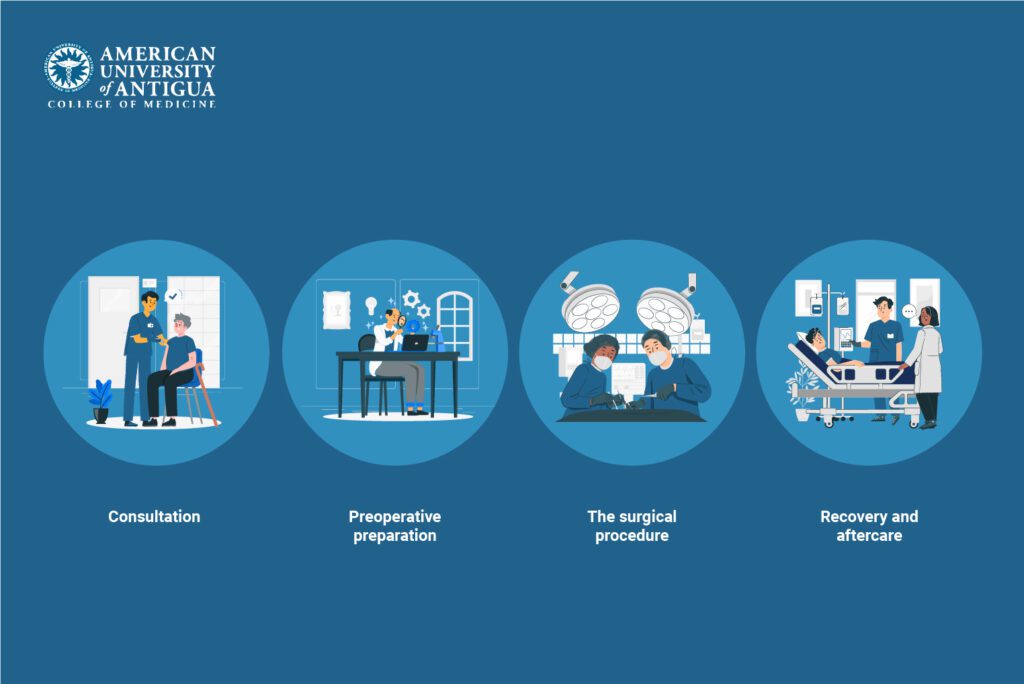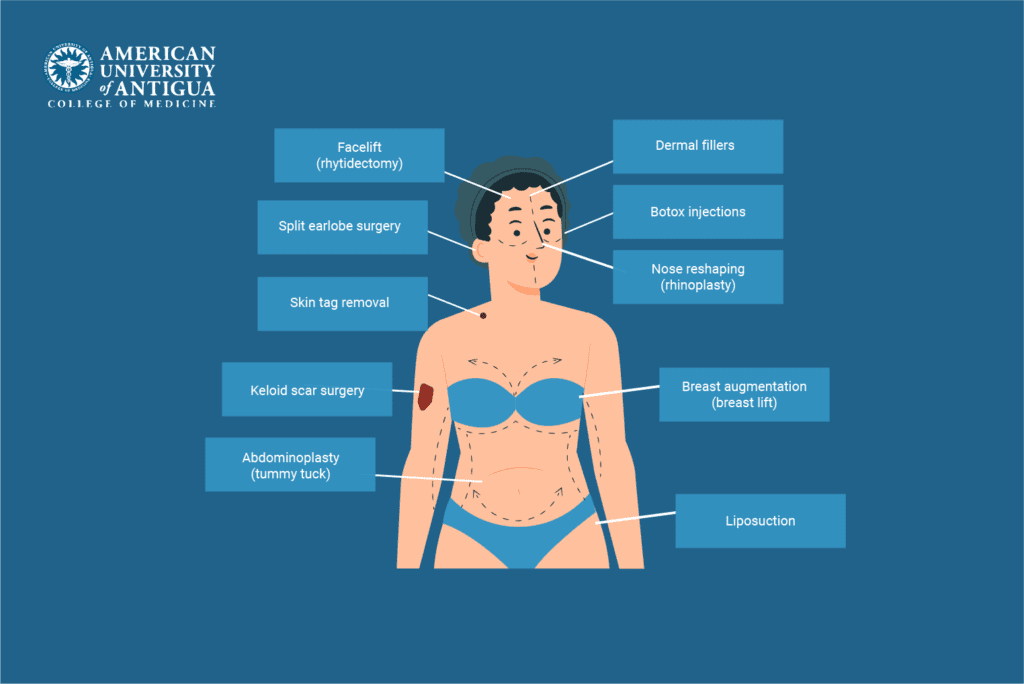What Is Plastic Surgery? Understanding Its Purpose
Plastic surgery is a medical technique that aims to enhance and restore a person’s body appearance and function.
Plastic surgery is becoming increasingly popular, with everyone from celebrities to everyday individuals opting for various procedures. According to the American Society of Plastic Surgeons survey, nearly 1.5 million cosmetic procedures were performed in the U.S. in 2023 only.
✅ Request information on AUA's MD program TODAY!
YOUR PATH TO SUCCESS BEGINS HERE
One common misconception about these procedures is that they are purely cosmetic and artificial. However, besides enhancing a person’s appearance, plastic surgery is used to restore and reconstruct facial and body tissue defects caused by illness, trauma, or birth disorders.
This article will explore the definition of plastic surgery, its history, various types of procedures, and the latest trends shaping the field.
What Is Plastic Surgery?
Plastic surgery is a medical specialty that involves reconstructing, restoring, or altering the human body. The term “plastic” originates from the Greek word “plastikos,” which means “to mold” or “to shape.”
The history of plastic surgery dates back to ancient civilizations. Early records from India around 600 BCE describe surgical techniques for reconstructing noses using skin grafts, highlighting the foundational principles of the discipline.
In the 16th century, Italian surgeon Gaspare Tagliacozzi advanced the field by developing methods for reconstructing facial features, particularly noses, using flaps of skin from the arm.
The modern era of plastic surgery began in the early 20th century, particularly during World War I, when innovations in surgical techniques emerged to treat soldiers with severe injuries.
Since then, significant advancements in anesthesia, surgical techniques, and materials have transformed plastic surgery into a widely accepted and sought-after practice for both reconstructive and cosmetic purposes.
Types of Plastic Surgery
Plastic surgery is categorized into two main types: reconstructive and cosmetic surgery, each addressing different needs based on medical or aesthetic reasons.
Reconstructive surgery
Reconstructive surgery aims to repair parts of the body that are affected by birth defects, diseases, or injuries, helping patients overcome physical challenges and improve quality of life. This type of plastic surgery includes procedures such as:
- Breast reconstruction: Often performed after a mastectomy, this surgery rebuilds the breast to restore its shape, especially for those recovering from breast cancer.
- Cleft lip and palate repair: This procedure corrects the orientation of the palatal muscles to improve palatal movement and create a foundation for intelligible speech.
- Trauma recovery: It restores the functionality and appearance after a surgery, e.g., facial reconstruction following an accident.
- Cancer treatment: It includes surgeries that remove cancerous tissues and reconstruct affected areas,
- Congenital conditions: It involves treating birth defects that affect daily life.
Cosmetic surgery
Cosmetic surgery focuses on improving an individual’s appearance. It is also known as aesthetic medicine because people usually choose to undergo this procedure to boost their self-esteem and get rid of any insecurities. Common cosmetic surgeries include:
- Rhinoplasty: This procedure alters the shape of the nose, which can also improve breathing.
- Facelift: It reduces deep wrinkles in the face, especially around the nose, mouth (smile lines), and chin (marionette lines).
- Liposuction: Also known as body contouring, this procedure removes excess fat to improve a person’s body appearance and smooth any irregular body shapes.
The Plastic Surgery Process

If you’re thinking about undergoing a plastic procedure, it’s crucial to have a clear understanding of the process that lies ahead.
Consultation
The journey begins with a consultation, during which you discuss your goals, expectations, and potential risks. You should choose a qualified and board-certified plastic surgeon to ensure you will achieve the desired outcomes.
During the consultation, the surgeon assesses your medical history, discusses available options, and develops a personalized treatment plan.
Preoperative preparation
During the preoperative phase, you will undergo medical evaluations and tests to ensure you are in good health for surgery. This phase can also involve discussions about the specific steps to take before the surgery, such as avoiding certain medications and adjusting lifestyle habits. Following pre-surgery instructions is vital to minimize risks and prepare for a successful surgery.
The surgical procedure
The surgery typically involves local or general anesthesia, depending on the procedure’s complexity. Surgical techniques used during the surgery vary, but they often include minimally invasive methods, which reduce recovery time.
The surgeon will perform the agreed-upon procedure, and the medical team will closely monitor your vital signs and well-being throughout the surgery.
Recovery and aftercare
The time of recovery varies by the type of procedure, but during this time, you are advised to rest and gradually return to normal activities. You will be given detailed instructions for at-home care and advised when to resume work and other daily activities. Postoperative care, including follow-up visits, is crucial for monitoring healing and addressing concerns.
Risks and Considerations
Like any surgical procedure, plastic surgery comes with risks and complications, including:
- Infection: Symptoms of an infection include redness, warmth, swelling, and discharge at the surgical site, as well as fever.
- Scarring: All surgeries leave scars, though their visibility varies.
- Anesthesia complications: Potential complications include respiratory issues or allergic reactions.
Understanding these risks is vital, along with considering the psychological impacts. Mental health evaluations can help ensure you are emotionally prepared for the changes you seek.
Trends in Plastic Surgery
Plastic surgery is continuously evolving, influenced by changing societal standards and technological advancements.
Popular procedures

The demand for minimally invasive procedures like botox injections and dermal fillers has increased due to their ability to provide subtle yet effective rejuvenation.
- Botox injections reduce wrinkles.
- Dermal fillers enhance facial volume and improve contours.
- Breast augmentation (breast lift) increases the size or alters the shape of the breasts.
- Liposuction removes excess fat deposits to reshape specific body areas.
- Nose reshaping (rhinoplasty) changes the shape, size, or proportions of the nose.
- Skin tag removal eliminates small, benign skin growths known as skin tags.
- Facelift (rhytidectomy) improves visible signs of aging in the face and neck.
- Abdominoplasty (tummy tuck) removes excess fat and skin and tightens muscles in the abdominal wall.
- Split earlobe surgery restores the normal shape of earlobes that have split or torn due to trauma, heavy earrings, or the natural aging process.
- Keloid scar surgery removes keloid scars, which are raised scars extending beyond the original injury site.
Technological advancements
Innovations in technology, such as robotic surgery and 3D imaging, are revolutionizing the field. Robotic-assisted procedures offer incredible precision and control. In addition, 3D imaging technologies enable surgeons to visualize and plan procedures with exceptional accuracy.
These technological advancements not only improve safety but also contribute to shorter recovery times, allowing you to resume your daily activities more quickly.
Conclusion
Plastic surgery is a specialized field that not only focuses on aesthetic enhancements but also on reconstructive procedures that restore function and improve quality of life. By blending artistry with medical expertise, plastic surgeons help people regain confidence and achieve their desired outcomes.
If you’re interested in exploring the world of medical sciences and pursuing a career that makes a tangible difference in people’s lives, consider enrolling in our Clinical Sciences Program. Take the first step toward your medical career today!
Frequently Asked Questions (FAQs):
Are there age limits for plastic surgery?
While there are no strict age limits, most surgeons prefer to perform elective courses on patients at least 18 years old, ensuring they are emotionally and physically mature.
What are the most common cosmetic procedures?
The most common cosmetic procedures include breast augmentation, liposuction, rhinoplasty, and botox injections.
How do I choose the right plastic surgeon?
To choose the right plastic surgeon, start by verifying their credentials and seeking board certification to ensure they meet high standards of skill and ethics. Reviewing before-and-after photos and reading patient reviews can also provide insight into their work quality and patient satisfaction.
✅ Request information on AUA's MD program TODAY!